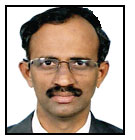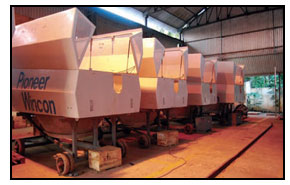 — S. Rajendran, Chief Operating Officer,
Pioneer Wincon Pvt Ltd
Pioneer Wincon
— S. Rajendran, Chief Operating Officer,
Pioneer Wincon Pvt Ltd
Pioneer Wincon belongs to the Pioneer Asia Group—the first entity
to install a grid-connected wind turbine generator in India, way back
in 1989. With over two decades of expertise, Pioneer Wincon has
become amongst the trusted and respected names in the wind
power industry. In an exclusive interaction,
S. Rajendran traces the
evolution of the company from its humble beginnings and charts
Pioneer's roadmap for the future. Rajendran also makes pertinent
policy recommendations to boost wind energy in India. An interview
by
Venugopal Pillai.
Pioneer Wincon has been in the wind power industry for over
two decades now. Tell us about the company's early days and
how the growth so far has been.
Our founder director Mr. S.Annamalai, a pioneer in the wind
industry, was the first person to connect a private wind turbine
generator to the Indian grid in 1989. Pioneer Wincon in the
same spirit has provided value to its investors as an end-to-end
wind solution provider since its inception in the mid-1990s. We
built a strong customer base through sustained product and
project quality, prompt service and a meditative focus on
customer satisfaction. We now have 1,000 wind turbines
installed all over the country.
We understand that Pioneer ended its technical collaboration
with Danish wind turbine maker Wincon, in 2003. What is your
view on inducting a technical partner in future?
During our collaboration period of around a decade with
Wincon there was a great deal of transfer of technology and
know-how to Pioneer. Wincon West Wind (Vestfrost) decided
to focus on their core business of white goods and hence
transferred the technology ownership to Pioneer. We have
taken this as a base and developed a strong engineering and
development team which has wealth of expertise to support
every aspect of the value chain that we participate in. Following
the exit of Wincon, we have been on a tremendous trajectory of
success with our products. From the point of view of our
existing products, we are completely self-sufficient.
However, we are seeking to collaborate with technology
partners to use the Pioneer brand name and our success track
record in the wind industry to bring higher capacity WTGs with
higher PLFs into the market.
Tell us about the various types of turbines that Pioneer makes.
How has been the market response to the new 750kW turbine?
Our product the P-250/29 has stood the test of time with close
to two decades of unimpeded evolution. It has won us the
distinction of a market leader in the 250 KW segment. The P250
is reputed for its ruggedness and reliability in operation backed
with excellent customer support.
While the P250 requires a smaller investment, the P750/49
strikes a balance between size of investment and energy
efficiency. Based on the winning features of the P250 design,
the P750 has been robustly engineered with high quality
components to deliver results. Little wonder that the P750 has received a good response from the market and is poised to
repeat the success of the P250 in its segment.
India has been adding around 3 GW of new wind power capacity
annually over the past few years. How do you see the market
potential in the coming years?
There is very good potential. If both the Central and State
governments give adequate support, the annual capacity
addition can go up to 5 GW in the next 2-3 years.
Do you suggest/recommendations specific policy measures to
boost the wind turbine market in India?
The recent withdrawal of Accelerated Depreciation (AD) and
the stalemate in the Generation Based Incentive (GBI) are seen
as retardant measures, coming at a time when the industry
needed a boost. AD should be allowed to continue to provide
strong impetus to SME sector investment for their captive
consumption purposes. GBI and REC (renewable energy
certificates) are strong growth drivers for IPP investment.
State governments should clear all arrears to wind power
generators and increase the power purchase rate in line with
market.
Power purchase rates should be applicable across the board
to all turbines instead of having differential rates for turbines
installed in different time period. Banking facility should be
allowed on annual basis across the country. Policy stability is
what the investors look at. Sadly enough, governments have
failed to appreciate this serious concern of the investors.
Planned augmentation of evacuation facility has to be done
with vision for future growth. While RECs are another well
designed driver for both the IPP and sale-to-board customers,
proper enforcement mechanisms of RPOs are to be devised and
implemented to keep RECs floating above the floor price and
closer to the ceiling.
 We observe that there are at least 20 wind turbine
manufacturers currently operational in India. How do you
assess the competitive scenario?
We observe that there are at least 20 wind turbine
manufacturers currently operational in India. How do you
assess the competitive scenario?
It shows the depth and maturity of the market. Yet, investors
are clear about what they want. There is space for various
types of turbines. Customers have a choice.
There is a huge growth potential in the wind industry as the
value of wind as solution to a more sustainable planet is
appreciated more and as the Cost of Energy (CoE) continues to
approach grid parity. The competition landscape is intense and
reflects that of a mature market.
There are several manufacturers with different products,
scales of investment, business models and target segments.
While the customer has a wide choice of options they are also
posed with a wide array of constraints such as a tough
financing environment.
Pioneer's technology has stood the test of time and the cost
of investment is low to moderate. We cater to a segment that
seeks to lower CoE and/or maximize their returns (ROI) with an
attractive scale of investment and with very low technical risk.
The value we provide our customers is well appreciated by
them.
What is your view on the potential offered by "re-powering" of
old wind farms? How is Pioneer tapping this opportunity? There is huge potential. There is a tremendous interest in our
machines. We are confident that we will re-power large
number of small turbines. We expect a favourable policy
incentivizing re-powering with efficient turbines.
What is your view on India's preparedness for offshore wind
farms?
It is too early to comment on this; one has to look at the
economics. European countries are far ahead thanks to
several factors working in their favour. Further, there is
tremendous onshore capability in India that needs to be fully
exploited through attractive policies and financing.
 Please summarize the general challenges faced by domestic
wind turbine manufacturers.
Please summarize the general challenges faced by domestic
wind turbine manufacturers.
Policy instability, evacuation infrastructure not keeping pace,
lack of government support to enable growth, withdrawal of
accelerated depreciation, variation in state-wise feed-in tariffs
and charges and lack of enforcement of RPO.
Indian wind farms operate at a PLF of 20 per cent, which
experts feel can be improved. What is your view?
The PLF of wind turbines is continually improving through
better technology. Advances in storage and smarter grid
solutions will mitigate some of the constraints that lower PLF
and intermittency that wind poses.
Pioneer Asia Group, as we understand, has been an energy
sector-intensive group. Apart from wind energy, are there
plans to tap other forms of renewable energy?
Yes, but for the time-being, the focus is wind.
Please summarize some corporate goals that you would like to
see Pioneer Wincon attaining in the coming years?
We would like to bring down cost of energy, offer 24/7
customer service; and leverage our strong customer base to
achieve 10 per cent market share by 2015.